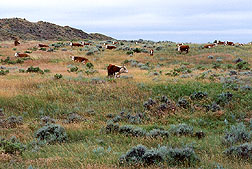This page has been archived and is being provided for reference purposes only. The page is no longer being updated, and therefore, links on the page may be invalid.
|
|
|
|
Global Warming May Lower Grassland Quality
By Rosalie Marion BlissMay 30, 2007
Rising atmospheric carbon dioxide (CO2) concentrations and air temperatures may lead to an increase in plant production, but a gradual decline in soil carbon and nitrogen. That's according to study findings reported by Agricultural Research Service (ARS) and Colorado State University (CSU) scientists in the April issue of New Phytologist.
The findings were the result of combined modeling and experimental exercises that explored the impacts of both warming and rising atmospheric CO2 on the ecology of native Great Plains grasslands. The results supported findings from the group's earlier studies, which indicated that future environmental changes could lead to lower nitrogen concentrations in forage grasses. That condition could negatively affect animal performance, since grazing animals need nitrogen-rich vegetation to facilitate digestion.
Plant physiologist Jack A. Morgan and colleagues at the ARS Rangeland Resources Research Unit cooperated with the study's lead author, William Parton of CSU. The scientists are based in Fort Collins, Colo.
The modeling experiment exercise was designed to test the responses from a new experiment just begun in southern Wyoming, the Prairie Heating and CO2 Enrichment, or PHACE study. The research team has spent two years developing the PHACE study's infrastructure, while the study itself will run for 5 to 10 years.
The scientists tailored an ecosystem model at the PHACE experiment site—based on the earlier experimental results—to help them investigate the effects of changes in climate and atmospheric CO2 in relation to carbon and nitrogen cycling.
A decline in forage quality of the grasslands of eastern Colorado and Wyoming would have a negative effect on not only livestock, but also native animals that have grazed there for thousands of years. The modeling exercise boosted researchers' confidence in the methods being used to assess ecosystems at the PHACE climate change experiment site.
ARS is the U.S. Department of Agriculture's chief scientific agency.

